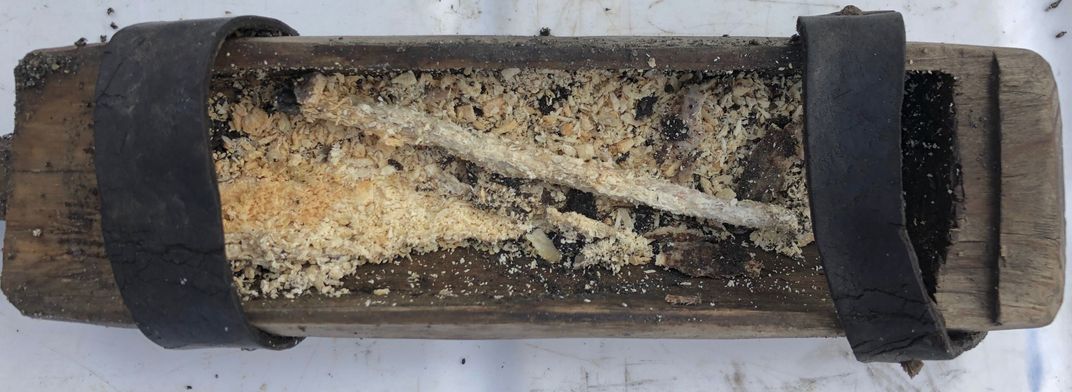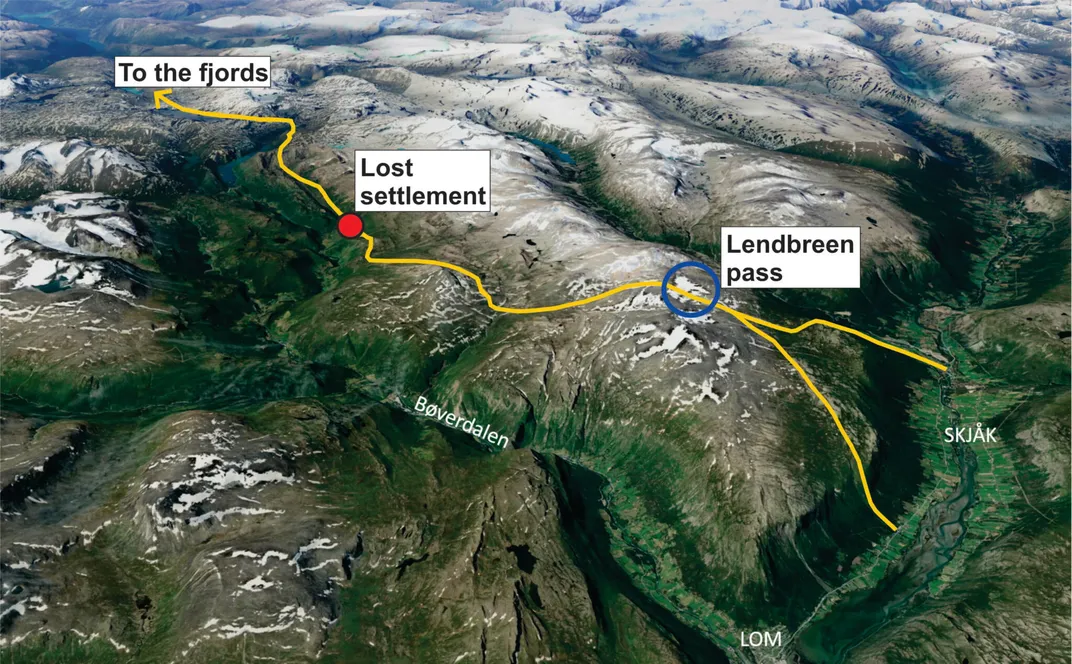Melting Glacier in Norway Reveals Remnants of Centuries-Old Beeswax Candle
Carefully preserved in a pine box, the item would have provided light for farmers who traversed the icy alpine pass
:focal(1004x370:1005x371)/https://tf-cmsv2-smithsonianmag-media.s3.amazonaws.com/filer/d7/17/d717d12a-286f-493f-bc0d-f105cde305e9/box.jpeg)
Archaeologists surveying the remote Lendbreen ice patch in Norway’s Jotunheim Mountains recently excavated a centuries-old wooden box. When they carefully lifted the sealed lid to examine its contents, the researchers encountered a surprise: Rather than holding pieces of tinder, as had been expected, the case contained the crumbled, yellowish remains of a beeswax candle.
The Innlandet County–based Glacier Archaeology Program (GAP) announced the find on its Facebook page last week. Per the statement, curators at the Museum of Cultural History in Oslo used radiocarbon analysis to date the box and candle to between 1475 and 1635 A.D.
As Megan Gannon reported for Smithsonian magazine last year, the Lendbreen patch rests high above the treeline in the Norwegian mountains. Today, it’s accessible only by helicopter or a rigorous hike. But hundreds of years ago, people frequented the site on foot or on the backs of livestock, traversing the 6,300-foot-tall mountain ridge on their way to trading posts, pastures and other destinations.
In April 2020, a major study of 60 radiocarbon-dated artifacts showed that travelers, merchants and farmers used the Lendbreen route as a thoroughfare between the Roman Iron Age (around 300 A.D.) and the Middle Ages. The authors, led by GAP co-director Lars Holger Pilø, suspect that use of the pass declined during a global cooling period known as the Little Ice Age. The Black Death, a plague that likely killed 40 to 50 percent of Norway’s 14th-century population, may have also contributed to the path’s waning popularity.

“The pass was at its busiest during the Viking Age around 1000 A.D., a time of high mobility and growing trade across Scandinavia and Europe,” study co-author James Barrett, an archaeologist at the University of Cambridge, told Smithsonian last year. “This remarkable peak in use shows just how connected even a very remote location was to wider economic and demographic happenings.”
As Bob Yirka reports for Phys.org, farmers and herders used the pass to drive cattle to summer pastures, where they would set up temporary homes for the spring to fall months—a process known as summer farming, or seterbruk.
One of these farmers may have dropped the newly recovered box, which was crafted out of pine wood and sealed shut to protect its contents from the elements. Though it might seem strange to transport a single candle in such elaborate packaging, the level of care reflects the object’s status as its owner’s sole source of light at night, notes George Dvorsky for Gizmodo.
“Such candle boxes are known from recent times here in Norway. They were used for transporting candles between the main farms and the summer farms. Now we know that such candle boxes were used way back in time,” says GAP in the statement. “It also fits well with what we know about the nature of the traffic through the Lendbreen pass.”

Rising temperatures linked to climate change continue to melt the region’s ice patches at an ever-increasing rate. But while the climate crisis holds potentially disastrous implications for the globe, melting glaciers have proven to be a small boon for European archaeologists, who suddenly have the chance to study rare items preserved in deep banks of ice and snow for centuries. (A more recent example of a glacier revealing its secrets comes from the Italian Alps, where a retreating chunk of ice uncovered a trove of World War I–era artifacts.) Still, teams are also forced to race against the clock to retrieve items from melting glaciers, as fragile ancient organic materials run the risk of disintegrating.
At Lendbreen, the particularly warm summer of 2011 revealed such historic finds as a spectacularly well-preserved greenish-brown tunic woven from lamb’s wool around 300 A.D. The shirt—the oldest piece of clothing ever found in Norway, according to Smithsonian—would have fit someone who stood about 5-foot-9.
Since the tunic’s discovery, archaeologists have uncovered more than 1,000 artifacts at the frozen pass, including leather shoes, walking sticks and a single horse snowshoe left behind by long-ago travelers. Researchers also found the bones of a domesticated dog, complete with its collar and leash.
Of these treasures, says GAP in the statement, the box and its waxy cargo stand out as “one of the most awesome finds we have discovered from the melting ice.”
/https://tf-cmsv2-smithsonianmag-media.s3.amazonaws.com/accounts/headshot/nora.png)
/https://tf-cmsv2-smithsonianmag-media.s3.amazonaws.com/accounts/headshot/nora.png)